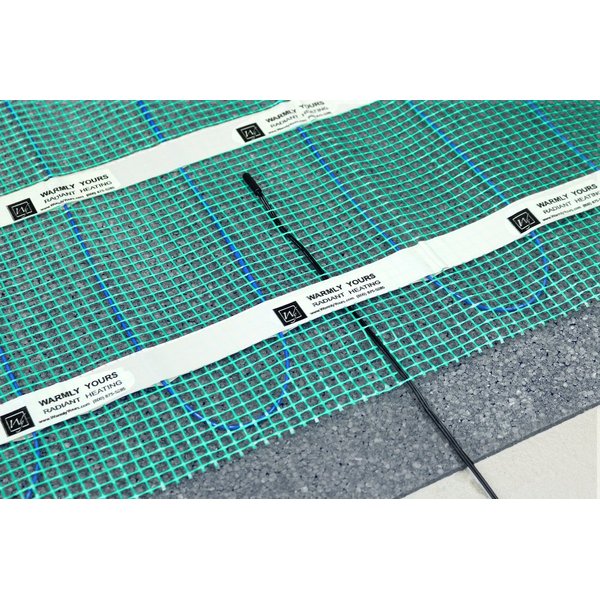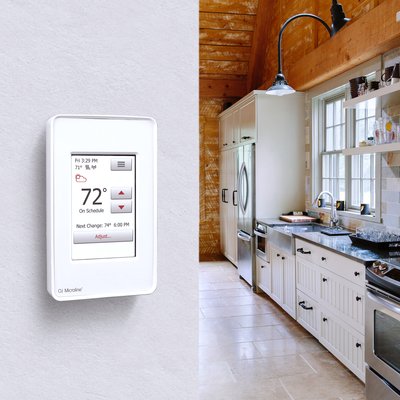It’s safe to say that every homeowner wants an energy efficient home. That’s because wasted energy means wasted money. As a result, more homeowners are identifying radiant floor heating as an attractive heating option. But how efficient is electric radiant floor heating and can using it translate into saving money?
Floor warming is virtually 100 percent energy efficient because of the way it transmits heat. It uses either electricity or hot water to heat a room from under the floor via infrared radiation. This means it uses direct contact to warm up the people and objects in a room. Unlike forced-air systems, there’s no blowing air, which means there’s no ductwork that’s susceptible to leakage. Therefore, as long as a room is insulated properly (with the right amount of insulation materials and the right types of insulation), both electric and hydronic (hot water) radiant heating systems offer no escape route for the heat.

Additionally, because radiant heating provides even heat throughout a room from the floor up, it allows the people in the room to feel warm even though the ambient (air) temperature in the room is lower. Other systems, like forced-air heating/air conditioning systems and radiators, often result in warm air hovering near the ceiling instead of closer to the floor, where the people are located. This leads many homeowners to run their systems for longer periods of time, using more energy, in order to attain the level of comfort they need.
The way radiant heating is delivered makes it inherently energy efficient; however, the home plays a vital role as well. To ensure as much energy conservation as possible, there are two things you should consider: insulation and a thermostat.
Proper Insulation
First, homeowners should ensure that the room and subfloor is properly insulated with a variety of insulation materials. There are many types of insulation. That means single-pane windows should be updated and wood-burning fireplaces should be properly maintained to prevent any heat from escaping. When not in use, the fireplace flue should be closed. If not, you’re giving your heat a free ride up and out of the chimney.
If your subfloor consists of a concrete slab, you’ll need to make sure to install a layer of insulation between the slab and the floor warming system. Concrete naturally absorbs heat. By adhering cork or synthetic cork floor underlayment to the slab before installing your radiant heating system, you’ll ensure that the heat goes upward through the floor instead of absorbing into the concrete below which will reduce energy use without sacrificing comfort.

To install the floor underlayment, you’ll first need to prepare your subfloor. Any significant cracks in your concrete slab should be patched; excess concrete lumps or debris should be removed; and the slab should be fully cured (particularly important if you've recently poured a concrete slab), dry, smooth, flat and susceptible to water penetration. If moisture in the slab is above 10 percent, you may want to seal the slab with a good quality concrete waterproof sealer or moisture barrier. Once the subfloor is ready, you should use a V-notched trowel to spread a layer of latex-modified thinset on the slab. Then, you can position the underlayment into the thinset. Stagger the seams of each sheet of underlayment just like brick work, then use a roller to ensure the underlayment has fully bonded with the subfloor. Let it cure for 24 hours and you’re ready to start installing the heating system and after that, the floor covering (we offer underfloor heating systems for everything from tile to carpet to hardwood floors).
It’s important to note that both electric and hydronic systems will raise the level of your floor. Electric radiant heating systems (consisting of heating cable or heating mats) are very thin, so they will only raise the floor height minimally, but hydronic systems will raise the height a little more noticeably. This should be taken into consideration before beginning a project.
Using a Programmable Thermostat
Once you’ve verified that your room is insulated properly, you can use a programmable thermostat to further enhance the underfloor heating system’s efficiency. Programmable thermostats allow the homeowner to set specific times and days for the system to kick on and off according to the homeowner’s schedule. Making sure the system is turned down or off when no one is home is a major way to promote energy conservation in addition to saving energy and money.
Smart thermostats are another energy efficient option, although you’ll want to check with your floor-heating system’s manufacturer to confirm which thermostats are compatible. Smart thermostats, like the Nest, have sensors that pay attention to whether a person is home or not. When they pick up on a routine, such as leaving the house every morning at 8 a.m., the thermostat learns to automatically turn the heat down or off while you’re away. Similarly, if it notices that you return home at 5 p.m. every afternoon, it will automatically schedule the heat to kick back on prior to that time. By anticipating homeowners’ behaviors, a smart thermostat can maximize the energy efficiency of your floor-heating system.

Many radiant heating manufacturers, like WarmlyYours, also offer adaptive thermostats that learn how long it takes a specific floor-heating system to reach temperature control so that they can factor that into the homeowner’s set schedule. Generally, hydronic systems take longer to heat up than electric systems do. This will play a role in determining how to most effectively program your thermostat. While both electric and hydronic systems are compatible with programmable thermostats, hydronic systems will not be as responsive as electric ones since they take longer to change temperature.
Regardless of the thermostat you use, your in-floor heating system is probably already saving energy because it’s inherently efficient. According to the U.S. Department of Energy, radiant heating “is more efficient than baseboard heating and usually more efficient than forced-air heating because it eliminates duct losses.” Typically, this efficiency means that supplementing your primary heating system with floor warming can result in longer term energy savings.
With a radiant heating system, proper insulation and a programmable thermostat at your fingertips (along with investing in Energy Star certified or otherwise energy efficient appliances), your home will be a triple threat that keeps homeowners warm without upsetting your bank account — or Mother Nature.
Interested in getting your own floor heating system? Check out our Operating Cost Calculator to see how much a radiant heating system would cost to run in your area.




